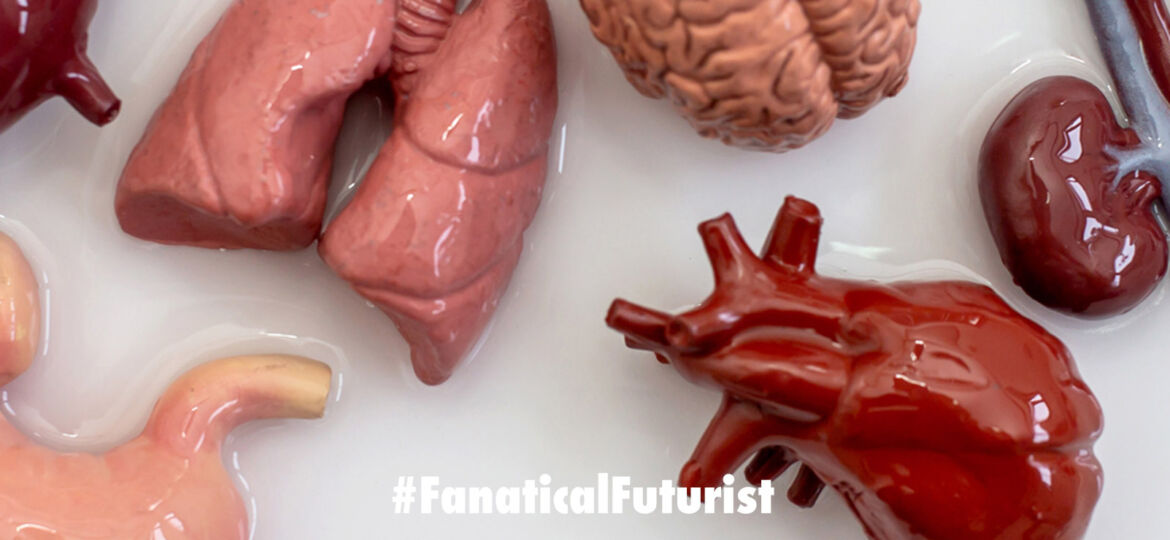
WHY THIS MATTERS IN BRIEF
3D Printing human organs has its problems so scientists created a 4D Bio-Printing technology to solve them and pave the way for better printed, on demand, human organs that grow with their hosts.
Interested in the Exponential Future? Connect, download a free E-Book, watch a keynote, or browse my blog.
Recently we’ve been using stem cells and 3D Bio-Printing to create and print a whole host of odd things – everything from tiny functioning human hearts and brain tissue, all the way through to human bone, cartilage, corneas, and skin, and even beef in space. But there’s a problem – like any type of tissue without the right support the 3D printed structures quickly collapse which makes some of these amazing breakthroughs useless when it comes to using them in humans. And this is where researchers think 4D printing, that’s being used experimentally by NASA to print self-assembling space stations and satellites in orbit, and where the fourth dimension is time, might help.
Cardiovascular disease is the leading cause of mortality worldwide, accounting for nearly 18 million deaths each year, according to the World Health Organization. In recent years, scientists have looked to regenerative therapies, including 3D printed heart tissue and stem cell therapies, to repair damage done to the heart and restore cardiac function. And thanks to advancements in 3D printing technology over the past number of years researchers have been applying cutting edge 3D bio-printing techniques, using printers that print living tissue not reports or pie charts, to create scaffolds that support the living tissue, but it’s not been enough and researchers have been finding that the tissues don’t integrate with native tissues in the body, which makes them functionally useless.
While 3D bio-printers can create 3D structures made of living cells the final product is static – it can’t grow or change in response to changes in its environment, AKA within the human body. And that’s the problem especially if you’re going tom be implanting the new organs and tissues into children, for example.
Conversely, in 4D Bio-Printing, a technology field so new it’s still in its shrinkwrap, researchers apply 4D printing strategies to create constructs using biocompatible, responsive materials or cells that can grow or even change functionalities over time in response to their environment. This technology could be a game-changer for human health, particularly in pediatrics, where 4D printed constructs as they’re known could grow and change as children age, eliminating the need for future surgeries to replace tissues or scaffolds that fail to do the same.
But, 4D bio-printing technology is still young, very young. One of the critical challenges affecting the field at the moment is the lack of advanced 4D printable bioinks – material used to produce engineered live tissue using printing technology – that not only meet the requirements of 3D bioprinting, but also feature the smart, dynamic abilities to regulate cell behaviours and respond to changes in the environment – wherever they’re implanted in the body.
Recognising this, researchers at George Washington University (GWU) and the University of Maryland are now working together to shed new light on this field after GWU Associate Professor Lijie Grace Zhang and UMD Professor and Chair John Fisher were recently awarded a joint $550,000 grant from the US National Science Foundation to develop new 4D bio-printing techniques to develop smart constructs for cardiovascular study.
Their main goal is to “design novel and Reprogrammable Bio-Inks that can create dynamic 4D-bioprinted constructs to repair and control the muscle cells that make up the heart and pump blood throughout the body.”
The muscle cells they’re working with – human induced pluripotent stem cell (iPSC) derived cardiomyocytes – represent a promising stem cell source for cardiovascular regeneration.
In this study, the bioinks, and the 4D structures they’re used to create, are considered “reprogrammable” because they can be precisely controlled by external stimuli – in this case, by light – to contract and elongate on command in the same way that native heart muscle cells do with each and every heartbeat.
The research duo will use long-wavelength near-infrared (NIR) light to serve as the stimulus that prompts the 4D bio-printed structures into action. Unlike ultraviolet or visible light, long-wavelength NIR light could efficiently penetrate the bio-printed structures without causing harm to surrounding cells.
“4D bio-printing is at the frontier of the field of bio-printing,” Zhang said. “This collaborative research will expand our fundamental understanding of iPSC cardiomyocyte development in a dynamic microenvironment for cardiac applications. We are looking forward to a fruitful collaboration between our labs in the coming years.”
“We are thrilled to work with Dr. Zhang and her lab to continue to develop novel bioinks for 3D and 4D printing,” Fisher said. “We are confident that the collaborative research team will continue to bring to light untapped printing strategies, particularly in regards to stem cell biology.”
Moving forward, Zhang and Fisher hope to apply their 4D bioprinting technique to further study of the fundamental interactions between 4D structures and cardiomyocyte behaviors.
“The very concept of 4D bio-printing is so new that it opens up a realm of possibilities in tissue engineering that few had ever imagined,” Fisher said. “While scientists and engineers have a lot of ground to cover, 4D bio-printed tissue could one day change how we treat pediatric heart disease, or even pave the way to alternatives to donor organs.”

















